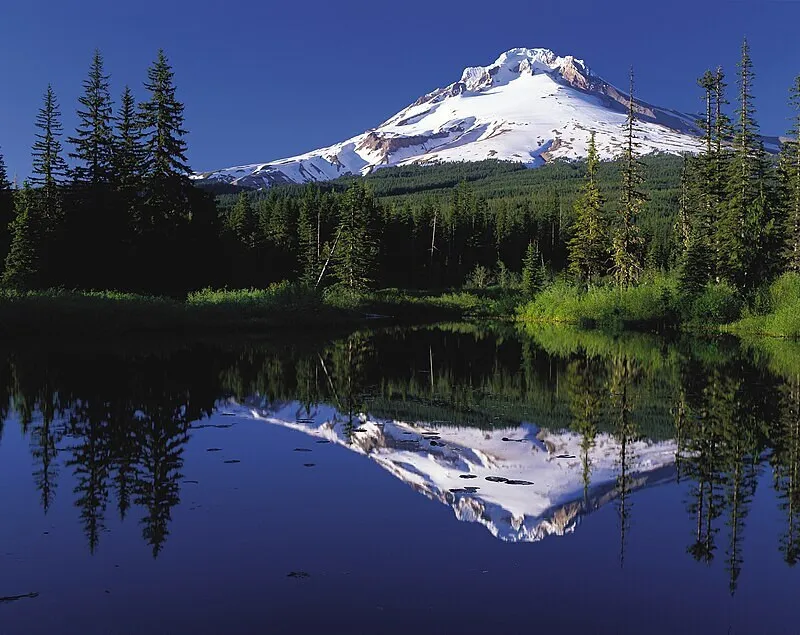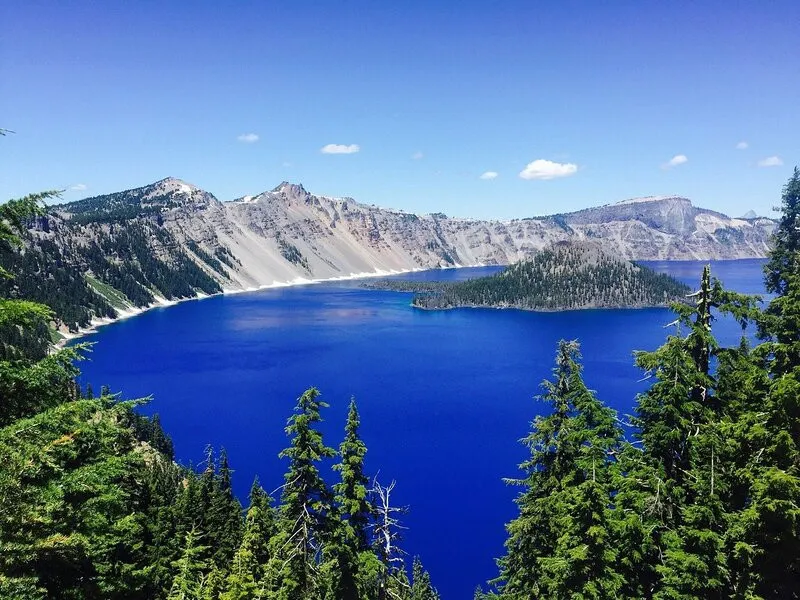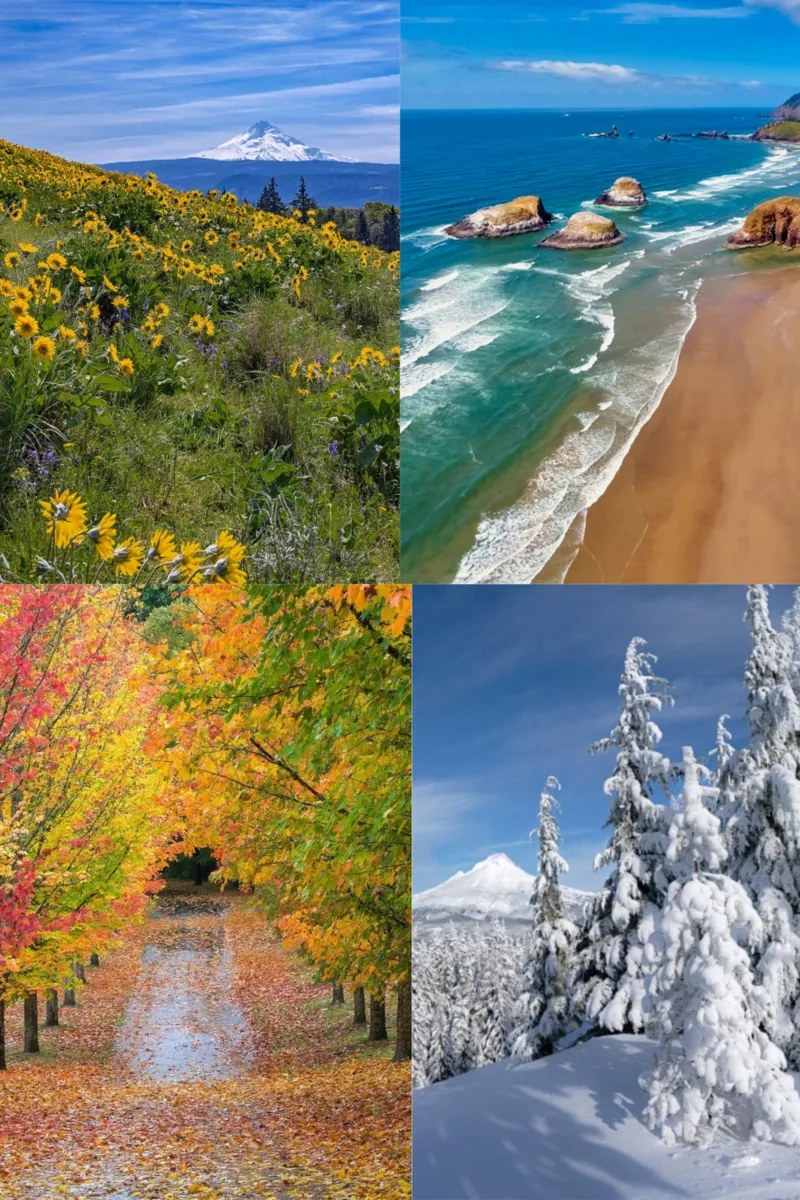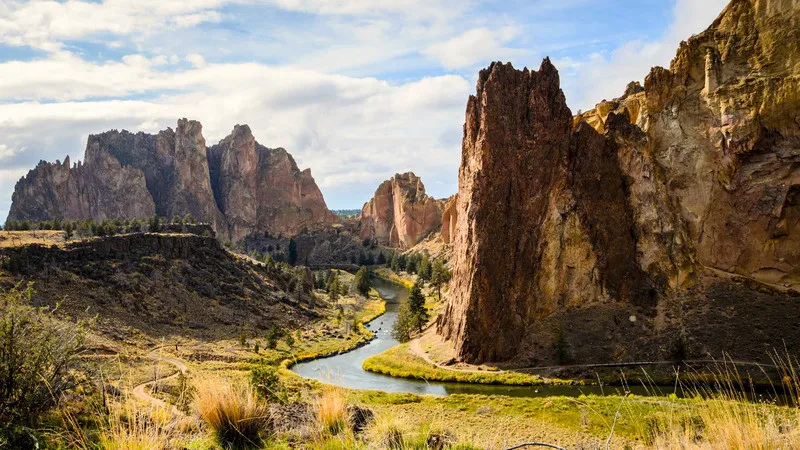Oregon, with its pristine and diverse natural beauty, is a dream destination for travel enthusiasts. Summer and autumn might be familiar seasons to visit, but have you ever considered exploring the beauty of Oregon’s national parks in winter? When snow blankets forests, mountain peaks, and lakes, Oregon dons a magnificent cloak, offering unique and unforgettable winter travel experiences. If you’re seeking a novel adventure, discover our detailed guide on how to visit Oregon’s national parks in winter for a safe and memorable journey.
Why Explore Oregon National Parks in Winter?
Winter in Oregon is not just a time of snow and cold; it’s also a season of tranquility, pristine beauty, and unique experiences rarely found at other times of the year. Here are reasons why you should consider visiting Oregon’s national parks in winter:
1. Magical Snow-Covered Beauty:
When snow falls, Oregon’s landscape transforms completely. Lush green pine forests are draped in white snow, creating stunning contrasts. Towering mountain peaks become even more majestic when covered in pure white snow. Crater Lake, already famous for its breathtaking beauty, becomes even more mystical and serene in winter.
2. Peace and Tranquility:
Winter is not peak tourist season in Oregon, especially in national parks. This means you’ll have the chance to enjoy quieter, more secluded spaces, away from the hustle and bustle of summer crowds. You can immerse yourself in unspoiled nature, listen to the wind rustling through snow-covered trees, and savor absolute silence.
3. Exciting Winter Activities:
Winter in Oregon opens up a range of unique recreational activities. Skiing and snowboarding are popular in mountainous areas. Snowshoeing is a fantastic way to explore the winter beauty of forests and mountains. Winter landscape photography offers unique artistic opportunities with the special light and colors of winter. Wildlife viewing in their snow-covered natural habitat is also a thrilling experience.
4. More Affordable Travel Costs:
In winter, prices for accommodation and travel services are often lower compared to summer. You can find attractive deals on hotels, lodges, and tours. This helps you save money and enjoy a more budget-friendly trip.
5. Cozy Winter Culinary Experiences:
After a long day exploring nature in the winter cold, there’s nothing better than enjoying warm and flavorful local cuisine. Oregon is renowned for its fresh seafood, hearty soups, stews, and fragrant pastries. You can find cozy cafes and restaurants to relax and savor distinctive winter dishes.

Ideal Oregon National Parks for Winter
While some areas in Oregon’s national parks may be difficult to access or partially closed in winter due to heavy snowfall, many parks and areas remain open and offer wonderful experiences. Here are some suggestions for ideal national parks and areas to visit in winter:
1. Crater Lake National Park:
Crater Lake is Oregon’s gem and one of the deepest lakes in the world. In winter, the deep blue lake is surrounded by snow-covered cliffs, creating an incredibly impressive scene. The Rim Drive may be partially closed due to snow, but the Rim Village area is usually open year-round and offers stunning views of the lake. You can snowshoe, cross-country ski, or simply admire the scenery and take photos.
Winter activities at Crater Lake:
- Admire snow-covered Crater Lake: Rim Village is an ideal viewpoint, easily accessible, and offers panoramic views.
- Snowshoeing: Trails around Rim Village are often groomed for snowshoeing.
- Cross-country skiing: Certain areas allow cross-country skiing; check information from the visitor center.
- Winter landscape photography: Winter light and white snow create stunning photos.
2. Mount Hood National Forest:
Mount Hood National Forest is a paradise for winter sports enthusiasts. Mount Hood, Oregon’s highest peak, is a popular ski destination with several ski resorts like Timberline, Mount Hood Meadows, and Ski Bowl. Besides skiing, you can enjoy activities like snowshoeing, snowboarding, and admiring majestic mountain views.
Winter activities at Mount Hood:
- Skiing and snowboarding: Timberline, Mount Hood Meadows, and Ski Bowl ski resorts offer various slopes for all skill levels.
- Snowshoeing: Many trails in the national forest are suitable for snowshoeing.
- Admire snow-covered Mount Hood: From various points in the national forest, you can admire the majestic beauty of Mount Hood.
- Visit Timberline Lodge: This historic lodge is a fascinating destination with unique architecture and stunning views.
3. Oregon Coast:
The Oregon Coast is not only beautiful in summer but also possesses a distinct and captivating charm in winter. Although the weather may be colder and rainy, you’ll witness pristine, secluded beaches, dramatic cliffs, and the fierce waves of the Pacific Ocean. Winter is also a great time for gray whale watching as they migrate along the Oregon Coast.
Winter activities on the Oregon Coast:
- Stroll on secluded beaches: Enjoy the peace and quiet of the winter coastline.
- Gray whale migration watching: Winter is when gray whales migrate south; you can observe them from coastal viewpoints.
- Visit coastal towns: Towns like Cannon Beach, Seaside, and Astoria remain open and offer local cultural and culinary experiences.
- Storm watching: If you enjoy excitement, winter is ideal for watching powerful ocean storms from the Oregon Coast.
4. Other State Parks and National Forests:
Besides the popular destinations above, Oregon has many other state parks and national forests worth exploring in winter, such as:
- Silver Falls State Park: Famous for the “Trail of Ten Falls,” still accessible in winter, but prepare for slippery conditions and tread carefully.
- Smith Rock State Park: A renowned rock climbing location, winter brings tranquility and fewer crowds.
- Deschutes National Forest: A vast national forest with numerous lakes, rivers, and mountains, suitable for snowshoeing and cross-country skiing.

What to Prepare for Visiting Oregon National Parks in Winter?
For a safe and comfortable winter visit to Oregon’s national parks, thorough preparation is crucial. Here’s a list of items and considerations to prepare:
1. Warm Clothing:
- Waterproof and insulated jacket: Choose a jacket with a waterproof, windproof outer layer and good insulation like down or synthetic materials.
- Fleece or thermal layers: Layering is key to staying warm in winter. Fleece or thermal layers help retain body heat.
- Insulated pants: Thermal leggings or fleece-lined pants are good choices to keep your legs warm.
- Waterproof gloves, wool hat, and scarf: Don’t forget to protect easily chilled areas like hands, head, and neck. Waterproof gloves, a wool hat, and a scarf will help keep you warm in cold weather.
- Thick wool socks: Keeping your feet warm is essential. Bring several pairs of thick wool socks to change as needed.
2. Non-Slip and Waterproof Footwear:
- Waterproof hiking boots: Choose boots with good non-slip soles and waterproof capability to keep your feet dry and safe on snow and ice.
- Snow boots: If you plan to participate in outdoor activities in deep snow, snow boots are ideal for keeping your feet warm and completely waterproof.
- Shoe traction devices (Crampons or Microspikes): If you’re hiking on trails with ice or hard-packed snow, traction devices will increase grip and prevent slips and falls.
3. Skin and Eye Protection:
- Sunscreen: Even in winter, UV rays can reflect off snow and harm your skin. Use high SPF sunscreen to protect your skin.
- Sunglasses: Sunlight reflecting off snow can cause glare and eye strain. Sunglasses will protect your eyes from bright light and UV rays.
- Lip balm: Cold and dry weather can cause chapped lips. Use lip balm regularly to keep your lips moisturized.
- Moisturizer: Winter weather can dry out your skin. Use moisturizer to keep your skin soft.
4. Equipment and Support Tools:
- Hiking poles: Hiking poles help you maintain better balance on slippery terrain and reduce pressure on your knees.
- Flashlight or headlamp: If you’re hiking in the evening or early morning, a flashlight or headlamp is necessary to illuminate your path.
- Map and compass or GPS device: Always carry a map and compass or GPS device for navigation and to avoid getting lost, especially in mountainous areas.
- Portable charger for phone and camera: Cold weather can reduce battery life of electronic devices. Bring a portable charger to ensure you always have enough power.
- First-aid kit: Carry a basic first-aid kit to treat minor injuries or unexpected incidents.
5. Food and Water:
- High-energy snacks: Bring snacks like energy bars, chocolate, nuts, dried fruit to replenish energy while hiking.
- Drinking water: Staying hydrated is crucial even in cold weather. Bring enough drinking water or a thermos with hot water or tea.
6. Emergency Contact Information:
- Emergency phone numbers: Record emergency phone numbers for the national park, police, rescue services, and nearest hospital.
- Inform family or friends: Before you go, inform family or friends about your itinerary and plans so they are aware and can contact you if needed.

Fun Activities at Oregon National Parks in Winter
Winter in Oregon’s national parks is not short of fun and exciting activities. Here are some suggestions to fully enjoy your trip:
1. Snowshoeing:
Snowshoeing is a fantastic way to explore the winter beauty of forests and mountains. Many national parks in Oregon have trails specially groomed for snowshoeing. You can rent snowshoes at visitor centers or sports equipment rental shops.
2. Cross-country Skiing:
Cross-country skiing is a great sport and an enjoyable way to explore winter nature. Some national parks and national forest areas have marked and groomed cross-country ski trails.
3. Downhill Skiing & Snowboarding:
If you love speed and thrills, downhill skiing and snowboarding are must-do activities. Mount Hood National Forest has several famous ski resorts with diverse slopes suitable for all skill levels.
4. Winter Landscape Photography:
Winter offers special light and color conditions for landscape photography. White snow, fog, weak sunlight, and clear blue skies create stunning and poetic winter photos.
5. Wildlife Viewing:
Winter is when wildlife exhibits special behaviors to adapt to harsh environments. You might have the chance to observe animals like deer, elk, squirrels, birds, and other wildlife in their snow-covered natural habitats.
6. Visiting Visitor Centers and Museums:
Visitor centers and museums in national parks are usually open year-round and provide useful information about park history, geography, flora, fauna, and activities. These are ideal places to learn more about the area you’re exploring and get advice from park staff.
7. Relaxing and Enjoying the Serenity:
Winter is the perfect time to seek peace and tranquility in nature. Take time to relax, breathe in the fresh air, watch the snowfall, and enjoy the absolute silence of a winter national park.

Tips for a Safe and Fulfilling Winter Visit to Oregon National Parks
For your winter visit to Oregon’s national parks to be safe and fulfilling, note these tips:
1. Check Weather Forecast and Road Conditions:
Before you go, carefully check the weather forecast and road conditions. Winter weather can change rapidly, and some roads may be closed due to snow or ice.
2. Learn About the Park:
Learn about the park you plan to visit, including opening hours, open and closed areas, permitted and prohibited activities, and safety regulations.
3. Travel in Groups or Inform Others:
If you’re hiking or engaging in outdoor activities, travel in groups or inform family or friends about your plans and expected return time.
4. Always Stay on Marked Trails:
To ensure safety and avoid getting lost, always stay on marked trails and follow directional signs.
5. Bring Enough Water and Snacks:
Even in cold weather, staying hydrated and energized is crucial. Bring enough water and snacks to replenish energy as needed.
6. Be Aware of Hypothermia and Frostbite Signs:
Cold weather can cause hypothermia and frostbite. Be aware of signs like shivering, fatigue, confusion, and numbness. If these signs appear, seek warm shelter immediately and warm your body.
7. Stay Away From Edges of Lakes, Cliffs, and Hazardous Areas:
In winter, areas like lake edges, cliffs, and hazardous zones can become slippery and more dangerous. Maintain a safe distance and heed warning signs.
8. Respect Nature and Wildlife:
When visiting national parks, respect nature and wildlife. Do not litter, do not make loud noises, do not feed wildlife, and do not damage the natural environment.
9. Prepare to Adapt to Changes:
Winter weather can change unexpectedly. Be prepared to adapt to changes and be ready to adjust your plans if necessary.
10. Enjoy the Experience:
Most importantly, fully enjoy the experience of exploring Oregon’s national parks in winter. Immerse yourself in pristine natural beauty, enjoy the tranquility, and create unforgettable memories. Wishing you a safe, fun, and memorable trip to Oregon’s national parks!